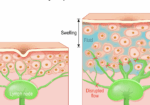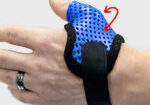Written by Melissa Miller
Introduction
After injury or surgery, nerves in the skin and surrounding the injured area can become overly sensitive. This can cause pain or an unpleasant sensation by stimuli that would not typically cause discomfort. For example, a light touch from a shirt or a certain material can feel like needles to hypersensitive skin. In the hand therapy setting, patients present with injuries to the upper extremity, causing hypersensitivity to crucial areas, such as parts of their hands, fingers, and forearms. When a patient is experiencing hypersensitivity in their upper extremity, it severely limits their ability to complete functional tasks such as dressing, cooking, and manipulating objects.
Desensitization
Desensitization (desensitization techniques for hypersensitivity) is a method in which you are constantly applying stimuli to the affected area of skin, providing the brain with extensive sensory input. [1] Over time the brain acclimates to that sensation, decreasing the uncomfortable, painful sensation that was perceived. [1] There are different methods in how you can desensitize the skin. One common method is using a sensory desensitization occupational therapy kit. Sensory kits can provide different stimuli depending on what type of stimuli the individual is sensitive to. A sensory kit can have different fabrics and textures; it can provide deep or lighter pressure, vibration, and even heat and cold. By providing a patient with a sensory kit, it enables them to desensitize the skin. Hence, they can do the activities and tasks they need to do throughout the day without pain or unpleasant sensation on the skin.
Our Sensory Kit!
We have provided sensory kits to many of our patients who have experienced hypersensitivity after an injury. Our sensory kit typically includes five materials that provide graded tactile stimuli. Our sensory kits are built from strapping and material that are used in the clinic. Here is our sensory kit!
Sensory Kit Material: graded from least intense tactile input (1), to greatest intensity of tactile input (5).
1. Soft/fuzzy Material- light and soft touch to begin desensitization
2. Soft strap – thicker then first material providing greater sensory input, but still soft
3. Velcro Strap – fuzzy and more wiry fabric for greater sensory input
4. Ace bandage – rougher fabric providing more intense sensory input
5. Foam Material – rough material for greatest intensity of sensory input
There are many methods to put together a sensory kit. What does your sensory kit look like?
Resources
[1] rsds (2020). Complex regional pain syndrome (CRPS) treatment: Desensitization. Retrieved from https://rsds.org/complex-regional-pain-syndrome-crps-treatment-desensitization/
2 Comments
Leave a Comment
More To Read
Comparing Edema and Lymphedema: Understanding the Differences and Treatment Approaches in Hand Therapy
Comparing Edema and Lymphedema: Understanding the Differences and Treatment Approaches in Hand Therapy As hand therapists we often encounter patients presenting with swollen arms, hands, and/ or fingers, often attributing these symptoms to various conditions. Two commonly confused terms in this area are “edema” and “lymphedema.” While both involve swelling, they have distinct causes, presentations,…
Read MoreCMC Arthritis Orthosis in the Hand: Mechanics and Purpose
One of the most common diagnoses we see in hand therapy is osteoarthritis of the 1st carpo-metacarpal joint where the metacarpal articulates with the trapezium. Also known as basal joint arthritis (CMC arthritis), this causes pain, joint deformity, loss of strength and loss of function. Patients come to us looking for relief of symptoms and…
Read MoreArthrodesis vs Arthroplasty in Thumb CMC OA
Piacenza A, Vittonetto D, Rossello MI, Testa M. Arthrodesis Versus Arthroplasty in Thumb Carpometacarpal Osteoarthritis: Impact on Maximal Voluntary Force, Endurance, and Accuracy of Pinch. J Hand Surg Am. 2021 May 24:S0363-5023(21)00199-4. doi: 10.1016/j.jhsa.2021.03.023. Epub ahead of print. PMID: 34045112. The Skinny: This was a retrospective study based on a convenience sample of individuals who…
Read MoreSensitivity and Specificity in Thoracic Outlet Syndrome (TOS) Tests in Hand Therapy
By: Mikayla Murphy Sensitivity and Specificity in Thoracic Outlet Syndrome (TOS) Tests in Hand Therapy Thoracic outlet syndrome (TOS) describes the compression of nerves, arteries, and veins as they pass through the thoracic outlet. Compression can occur at the interscalene triangle, the costoclavicular triangle, and the subcoracoid space (Physiopedia, n.d.). There are three types of…
Read MoreSign-up to Get Updates Straight to Your Inbox!
Sign up with us and we will send you regular blog posts on everything hand therapy, notices every time we upload new videos and tutorials, along with handout, protocols, and other useful information.







Great ideas for desensitization! Easily made for our clients.
Thank you for sharing.
Awesome, easy, practical suggestions! Thank you!